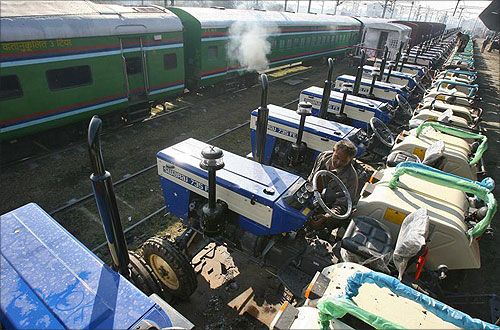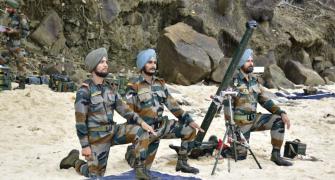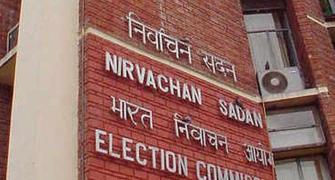Indian Railway’s sustenance, freight traffic, - which accounts for about 70 per cent of its revenue - has been plateauing of late, says Ramakrishnan T S.
 Instead of analysing what was wrong with its freight service model, Indian Railways went for the knee-jerk measure of reducing freight rates.
Instead of analysing what was wrong with its freight service model, Indian Railways went for the knee-jerk measure of reducing freight rates.
Result: loss in revenue. In such a situation it will be difficult for the Railways to retain its existing freight transport volume
With the passage of the Goods and Services Tax (GST) Bill in Parliament, there is a sense of well-being in the country, as it is expected that this tax would turn India into a single market, cut the flab in the logistics industry and remove distortions created by inter-state taxes, thereby make the manufacturing sector more competitive.
Growth of the manufacturing sector would spur growth of the logistics industry.
The transport sector would be happy with the double benefit of growth in its business and reduction in transportation costs.
But Indian Railways (IR) should be worried with the arrival of the GST, unless it wants to remain in a sthitpragya state.
Why so? Because IR’s sustenance, freight traffic, - which accounts for about 70 per cent of its revenue from transport operations - has been plateauing of late, registering about 1.095 billion tonnes in 2014-15 and 1.107 billion tonnes in 2015-16.
Indian Railways had commissioned the National Council of Applied Economic Research (NCAER) to assess the prospects of its freight traffic in 2016-17 as well as to suggest possible strategies.
NCAER recommended reduction of freight rates, removal of 10 per cent port congestion charges, review of 15 per cent season surcharge, some changes in operations such as reviewing the two-point loading restriction, restoring the long-term committed business segment of short-distance freight traffic with concessions and abolishing dual freight rates for transporting iron ore (30 per cent more for export than for domestic use).
All these recommendations were made essentially on the principle of price elasticity - that with decreased freight charges, demand would increase substantially and hence, overall revenue would also increase.
IR removed 10 per cent port congestion charges and 15 per cent season charges effective from May 1, 2016. It abolished dual freight rate for transporting iron ore effective from May 10.
These measures did benefit IR - a three per cent overall increase in freight loading - but there was also a seven per cent overall drop in revenue in June 2016 compared to June last year.
This apart, in April and May this year, there was a decrease in freight loading by two per cent from the figure during the same months in 2015.
In a nutshell, IR did not generate as much revenue in the first quarter of 2016 as it did in the same quarter last year.
Neither the existing freight charges nor the reduced freight charges helped IR increase its revenue from freight traffic - decreased freight charges did help it transport some more freight but with a loss of revenue. Why?
Price elasticity works only when the service delivery is the same across competitors. IR’s service delivery has been worse than other transport modes.
It became convenient for IR to go for the knee-jerk measure of reducing freight rates based on the NCAER report without even assessing by itself what was essentially wrong with its freight service model.
NCAER, on its part, did not analyse the issue in a holistic manner to arrive at path-breaking solutions to increase rail freight traffic.
What was the core issue that stopped IR from increasing its freight transport output?
It is this: IR has been unable to provide faster and timely transportation of non-bulk freight transport and hence has been unable to make a foray into non-bulk freight transportation.
Whether it is the transportation of raw material, partly processed goods or finished goods, those who look for faster and committed delivery don’t prefer transporters who transport goods at their own will and are non-committal about delivery.
To understand this fully, we need to know the freight transport pattern in general.
There are two categories of freight - bulk and non-bulk materials. Materials defined by weight and volume such as coal, iron ore, food grains, petroleum and cement are bulk materials.
There is a qualitative difference in the transportation and handling of bulk and non-bulk materials.
Some of the bulk items such as iron ore and coal are of low value, whereas most of the non-bulk items are invariably of high value.
Materials in transit also form the inventory. Hence, the transportation of non-bulk materials happens in smaller consignments, rather than accumulating and transporting them in one go.
End-to-end transport also has to be faster, safer (for the material) and the material has to be delivered in the committed time, even if the transportation cost is higher.
On the other hand, the sole criterion for transportation of low-value bulk material is that it should be cheap.
Given this condition, IR had a clear edge over road transport in transporting low-value bulk materials of coal and iron ore.
IR also has an edge in transportation of high-value bulk materials such as cement, fertilisers, food grains, petrol, oil and lubricants, especially if these are transported over long distances.
As a result, bulk items contribute about 89 per cent of freight loading and 85 per cent of freight earnings of IR.
However, IR pays a price for transporting bulk items, as 40 per cent of the wagon movement is on empty rakes.
This is a huge flab IR carries for capturing and retaining low-value bulk material transportation.
In bulk freight traffic, coal is the single major source of revenue for IR, contributing about 30 per cent, against 29 per cent of the entire passenger transport.
Hence this would hit IR’s financials. The NCAER study estimated that freight transport for IR would grow at 2.1 per cent in 2016-17 and half the growth would come from coal alone.
However, IR may not be able to achieve any addition to coal transportation volume as conditions are not conducive.
As of 2016 India has surplus power and its power sector has been steering towards solar power.
Against this backdrop, IR cannot depend any more on coal to augment its freight traffic and hence, its revenues.
Moreover, pipeline and coastal shipping have also forayed into transportation of bulk items, giving IR tough competition.
For medium distances, cement transportation has already moved towards trucks.
In such a situation, it is difficult for IR to retain existing bulk freight transport volume, let alone augment it.
(This is the first of a two-part series.)
The author is a Doctorate in Public Systems from IIM Ahmedabad and currently teaches at TAPMI, Manipal. The views are personal.
Photograph: Reuters








